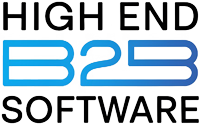Running a small business is a juggling act. Between managing operations, handling clients, and growing your revenue, there’s barely enough time to breathe—let alone code custom software or workflows. If that sounds like you, it might be time to explore the world of no-code automation platforms for small business.
These tools are designed to let you automate repetitive tasks, streamline processes, and connect the apps you already use—without hiring a developer. no-code automation platforms. Whether you’re looking to automate lead capture, send personalized emails, or sync data across platforms, there’s a no-code tool for that. no-code automation platforms.
Why No-Code Automation Is Exploding in 2025
We’ve reached a tipping point where small teams can now run powerful, automated workflows once reserved for enterprise-level budgets. Thanks to these no-code platforms, you can now:
- Eliminate repetitive tasks (no more manual data entry!)
- Connect apps like Slack, Gmail, Airtable, Stripe, Calendly, and 5000+ others
- Scale operations faster with fewer team members
- Create powerful automations in minutes, not months
Let’s dive into the top no-code automation platforms every small business should know about in 2025.
1. Zapier – The Gold Standard for No-Code Workflows
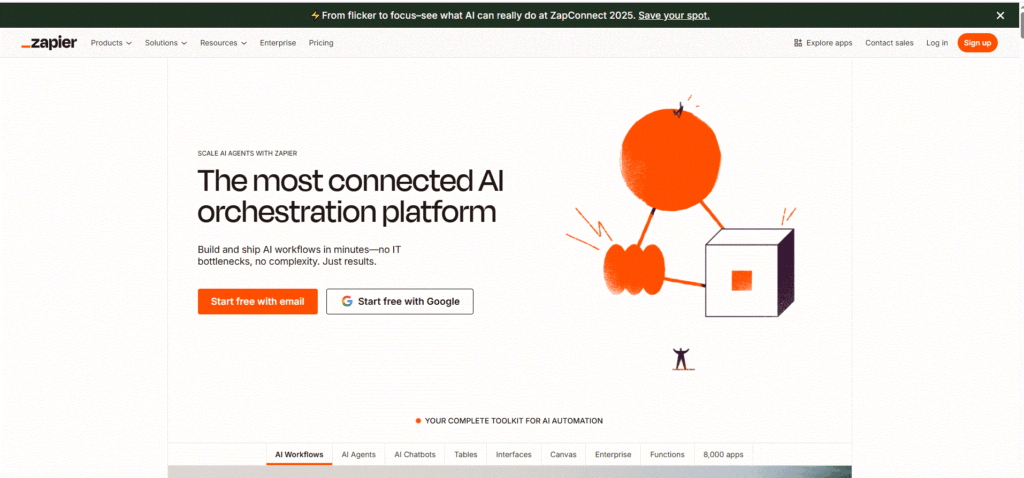
Official Website: Visit Zapier
If you’re new to no-code, Zapier is the OG automation platform. It connects over 6,000 apps, letting you trigger actions between tools like Gmail, Google Sheets, Stripe, Trello, and more.
It’s drag-and-drop simple, yet powerful enough for advanced multi-step workflows.
Key Features:
- Connect 6000+ apps
- Multi-step automation (called Zaps)
- Filters, delays, paths for conditional logic
- Built-in apps for email, schedule, format, code, etc.
Pros:
- Extremely easy to use
- Huge integration ecosystem
- Free plan with basic features
- Scales as your team grows
Cons:
- Gets expensive with volume
- UI can feel dated
Best For: Non-technical teams who need flexible integrations fast.
2. Visual Automation Powerhouse
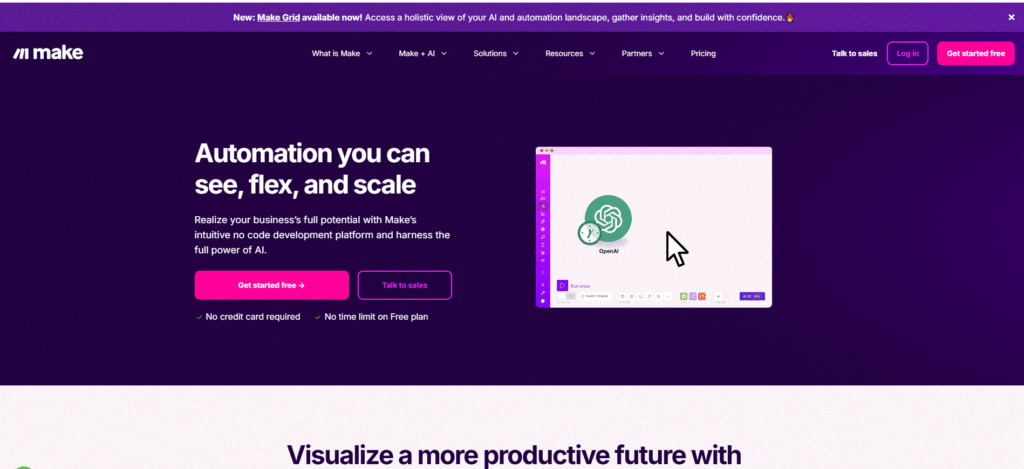
Official Website: Visit Make
If Zapier is the king of simplicity, Make is the master of visual logic. It gives you full control over how your data flows, with beautiful drag-and-drop flowcharts and advanced logic for power users.
Key Features:
- Visual scenario builder
- Support for complex branching and loops
- Over 1000+ supported apps
- Real-time data transfer
Pros:
- Visual automation makes logic easy to follow
- Extremely flexible for advanced workflows
- Affordable pricing
- Powerful free tier
Cons:
- Slight learning curve
- UI can feel technical at first
Best For: Tech-savvy users and teams that need precision automation.
3. Pabbly Connect – Affordable Alternative to Zapier
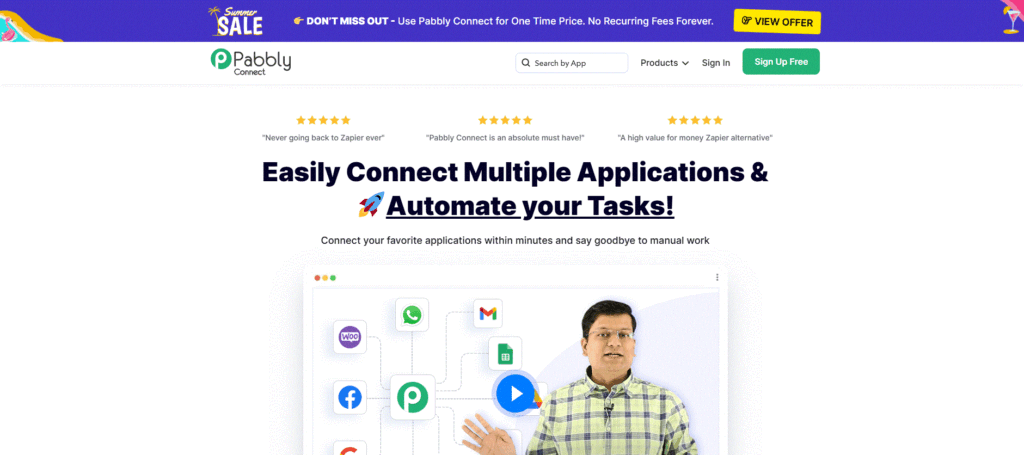
Official Website: Visit Pabbly Connect
Pabbly Connect has gained traction fast—mainly because of its lifetime deal model and wallet-friendly pricing. While it supports fewer apps than Zapier or Make, it offers unlimited workflows and triggers.
Key Features:
- Unlimited workflows on paid plans
- Webhooks, filters, delays, routers
- Supports major business tools
- Lifetime pricing options available
Pros:
- One-time payment options
- Simple and intuitive interface
- Unlimited tasks on higher tiers
Cons:
- Smaller integration library
- Slower updates than competitors
Best For: Small businesses looking for value and long-term savings.
4. Tallyfy specializes – Workflow Automation for Client Approvals
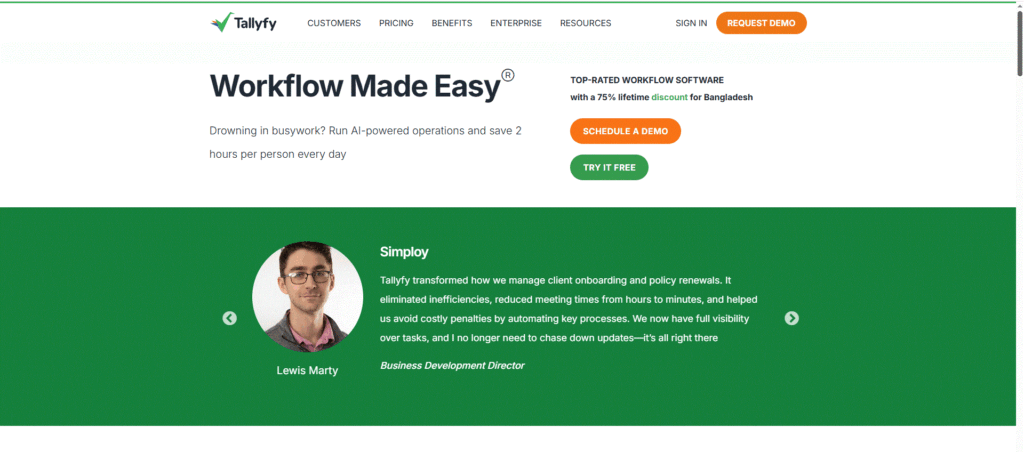
Official Website: Visit Tallyfy
Tallyfy specializes in workflow approvals and business processes that involve people—not just data. If your business needs checklists, approvals, and human interaction in automation, Tallyfy is the way to go.
Key Features:
- Approval workflows
- Task tracking and assignments
- Workflow templates
- Integration with Slack, Zapier, Google Workspace
Pros:
- Great for processes that need human input
- Very visual and user-friendly
- Replaces internal SOP documents
Cons:
- Not ideal for fast API-based automations
- More expensive than some tools
Best For: Agencies and service providers managing repeatable client tasks.
5. Airtable Automations – No-Code + Database Magic

Official Website: Visit Airtable
Airtable is like if Google Sheets and a relational database had a no-code baby. It’s beloved for its flexibility and now includes native automations, so you can trigger actions based on data updates.
Key Features:
- Create forms, tables, and relational databases
- Automate actions (email, Slack, updates)
- App-like interface with blocks
- Real-time sync with external sources
Pros:
- Extremely versatile (can build CRMs, dashboards, etc.)
- Great templates and UI
- Easy to scale as you grow
Cons:
- Automations are still basic compared to others
- Paid plans needed for serious use
Best For: Teams managing lots of structured data with need for automation.
6. N8N – Open Source Automation for Developers & Tinkerers
Official Website: Visit N8N
N8N (“Node Node”) is a self-hostable workflow automation tool with a developer-friendly spin. Unlike Zapier, it’s open source, meaning you can run it on your own server—and deeply customize workflows.
Key Features:
- 300+ native integrations
- Visual editor for workflows
- Self-hosted or cloud hosted
- Full control over execution logic
Pros:
- Open source and customizable
- No per-task pricing when self-hosted
- Deep integrations with APIs
Cons:
- Not beginner-friendly
- Requires hosting and setup knowledge
Best For: Developers, technical founders, and privacy-conscious teams.
7. HubSpot Workflows – CRM-Powered No-Code Marketing Automation
Official Website: Visit HubSpot
HubSpot Workflows lets you build complex, automated marketing sequences inside your CRM. Without touching a line of code, you can trigger personalized emails, assign sales tasks, score leads, and update CRM records. It’s like having an automated marketing assistant working 24/7.
Key Features:
- Visual workflow builder
- Email nurturing, lead scoring, CRM automation
- Triggers based on customer behavior
- Built-in A/B testing and performance analytics
Pros:
- Deep CRM and marketing tool integration
- Excellent UI and onboarding
- Enterprise-grade power for growing businesses
Cons:
- Expensive as your list grows
- Advanced features require higher-tier plans
Best For: SaaS startups and service businesses already using HubSpot CRM.
8. Outfunnel – Sync CRM and Marketing in One Click
Official Website: Visit Outfunnel
Outfunnel automates the connection between your CRM and email marketing tools. Perfect for small teams, it ensures your marketing campaigns reflect your sales pipeline without manual syncing. no-code automation platforms.
Key Features:
- Integrates with Pipedrive, HubSpot, Copper
- Syncs CRM contacts with Mailchimp, ActiveCampaign, etc.
- Web tracking and lead scoring
- Trigger campaigns from CRM activity
Pros:
- Easy setup for sales/marketing alignment
- Real-time contact sync
- Designed for small B2B teams
Cons:
- Limited tool integrations
- Not a full workflow builder like Zapier
Best For: B2B marketers who want fast, accurate lead follow-up without complexity.
9. Levity – No-Code AI Workflows for Smart Automation
Official Website: Visit Levity
Levity adds artificial intelligence to your automation stack without needing a data science degree. Train custom AI models to automate document sorting, email responses, and more—right from your browser.
Key Features:
- Train AI models with your own data
- Automate classification of emails, images, and documents
- Connect with Slack, Gmail, and Notion
- Drag-and-drop automation builder
Pros:
- AI superpowers with no coding
- Intuitive training and setup
- Perfect for operations and support teams
Cons:
- Niche use cases
- Requires a base of training data
Best For: Teams that deal with repetitive document or message classification.
10. Workflow86 – Advanced Internal Process Automation
Official Website: Visit Workflow86
Workflow86 focuses on automating internal business processes—things like onboarding, SOPs, approvals, and form-based tasks. It’s a full-stack operations engine that doesn’t need APIs to function. no-code automation platforms.
Key Features:
- Drag-and-drop builder for workflows
- Internal forms, branching logic, approvals
- Built-in audit trail and version control
- No third-party tools required
Pros:
- Ideal for managing internal ops
- Clean UI with logical process mapping
- Fully self-contained solution
Cons:
- Less effective for external customer workflows
- Takes time to master complex flows
Best For: HR, legal, admin, and ops teams standardizing internal tasks.
Comparison Table: Best No-Code Platforms for Small Business
| Tool | Best For | My Take |
|---|---|---|
| Zapier | Beginners & general automation | Fast and reliable. Still the no-code king. |
| Make | Tech-savvy users needing logic | Visual automation done right. |
| Pabbly Connect | Budget-conscious businesses | Best value for lifetime automation. |
| Tallyfy | Approval workflows, client services | Excellent for process transparency. |
| Airtable | Structured data and dashboards | Flexible, visual, and deeply customizable. |
| N8N | Developers and open-source fans | Perfect for self-hosting and APIs. |
| HubSpot | CRM-focused marketing teams | Full-stack automation inside your CRM. |
| Outfunnel | CRM and email sync for B2B | Ideal for aligning sales + marketing. |
| Levity | AI-based document & message workflows | No-code meets machine learning brilliance. |
| Workflow86 | Internal ops and SOP automation | Built for serious internal process needs. |
(FAQ) For no-code automation platforms
What is a no-code automation platform?
A no-code automation platform lets you build automated workflows between apps and services without writing any code. These tools use visual editors and drag-and-drop functionality so anyone—regardless of technical experience—can automate repetitive tasks.
Which is better: Zapier or Make?
Zapier is better for beginners and fast setup, while Make offers more control and flexibility for advanced users. If you prefer a visual flowchart-style interface with branching logic and loops, Make is your go-to. For plug-and-play simplicity, Zapier wins.
Are no-code tools safe for business use?
Yes, most reputable no-code platforms like Zapier, Make, and Airtable follow strict security protocols, including data encryption, GDPR compliance, and two-factor authentication. Always check the vendor’s security page before using for sensitive workflows.
Can I run my entire business using no-code tools?
In many cases—yes. Startups and small businesses often run CRMs, lead generation, email marketing, and even internal SOPs using only no-code tools like Airtable, Tallyfy, and Pabbly Connect. However, as your company grows, you may combine no-code with custom dev work.
What’s the best no-code tool for beginners?
Zapier is widely considered the easiest entry point due to its intuitive interface, large template library, and wide app ecosystem. Pabbly Connect is another great option for budget-conscious beginners.
Final Thoughts: Which One Should You Choose?
There’s no one-size-fits-all when it comes to no-code automation platforms for small business. The right choice depends on your goals:
- Want general automation? Go with Zapier or Make
- Need to save money? Pabbly Connect is your friend
- Handling client approvals? Try Tallyfy
- Running a CRM-first business? HubSpot Workflows is gold
- Fancy yourself a tinkerer? Dive into N8N or Levity
The key is to start small—automate one workflow, then another. Before you know it, your business will run smoother, faster, and with less effort. For no-code automation platforms.
Related Read: 10 Must-Have Tools for SaaS Startups in 2025
